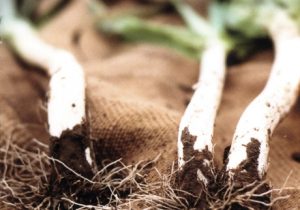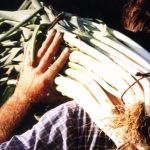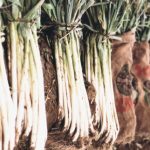
Name
Cervere Leek
Seal of quality
 Prodotto Agroalimentare Tradizionale (PAT) / Typical food-farming product.
Prodotto Agroalimentare Tradizionale (PAT) / Typical food-farming product.
Description
On the outside, this leek has a long, thin stalk, half of which is white, and is usually sold in typical bunches of 20-30 leeks of the same size with the green part cut just above binding point.
Its sweet and delicate taste is completely different to that of garlic and onions of which it is a close relation. It is sowed between the middle of March and the middle of April. Transplantation is carried out between the middle of June and the middle of July, in rows about one metre away one from the other. From September on, the seedlings are earthed-up by hand many times, after thinning the leaves, until the white part reaches a height of even 60 cm . The leek reaches maturation at the end of October and can be harvested throughout the winter season. The crop is tied to traditional methods that have been handed down from one generation to the next, and that adapt with difficulty to any type of mechanisation and, therefore, a great deal of manual work is involved which is an impediment to large-scale production.
The leek cropped in autumn is easily stored during the winter period, being protected from the cold in dark and closed places, or tied in bunches and covered with a 15-20-centimetre layer of fresh sand below ground, or in outdoor pits protected by a layer of dry leaves or hay. Those who do not have a vegetable garden or garden can store the leeks in a closed container, away from the light, even on a balcony or in the cellar.
Nutritional characteristics
Like all vegetables, he leek is a low-calorie, fat-free food, and has a very low sugar content, and on average is rich in Vitamins C, PP, A, B, B2 and in iron.
| FOOD | Porri crudi | |
|---|---|---|
| Edible part | % | 77 |
| Water | g | 87,8 |
| Protein | g | 2,1 |
| Fat | g | 0,1 |
| Carbohydrates | g | 5,2 |
| Starch | g | 0 |
| Soluble sugar | g | 5,2 |
| Total fibre | g | 2,9 |
| Energy | kcal | 29 |
| Kilojoules | kJ | 120 |
| Sodium | mg | |
| Potassium | mg | |
| Iron | mg | 0,8 |
| Calcium | mg | 54 |
| Phosphor | mg | 57 |
| Thiamine | mg | 0,06 |
| Riboflavin | mg | 0,08 |
| Niacin | mg | 0,5 |
| Vit A ret. eq. | mcg | tr |
| Vit C | mg | 9 |
| Vit E | mg |
Area of production
The commune of Cervere.
History
Little is know about the origins of this species. The leek was already known and grown in ancient Egypt, where it was eaten by the slaves working on the pyramids. From that period, it continued along the centuries into the Roman-Greek period. Pliny named the plant “porrum”. In the Medieval Ages, the leek, together with a limited number of other plants, solved the food problems during famine and pestilence, which recurrently struck the populations. Today, the leek is known, cultivated and distributed throughout the world. Evidence of the ancient tradition of Cervere leek cultivation can be found both in the local variety, a “massale” selection (carried out by hand to improve the quality of the final product) of the variety “porro lungo d’inverno” (long winter leek), traditionally named and known as “Cervere”, and in the methods of cultivation handed down from generation after generation. The “Porro di Cervere” represents more than two thirds of the entire leek crop in Piedmont .
In November 1996, the “Consorzio per la valorizzazione e la tutela del Porro di Cervere” was founded under the patronage of the Province, the Chamber of Commerce and the Commune, with the objective of promoting leek crops which, in the past, had undergone strong contraction to such a point that they almost risked extinction. The Consortium is provided with a seal and with management regulations: the seal appearing on each bunch of leeks on sale is guarantee of its origin.

